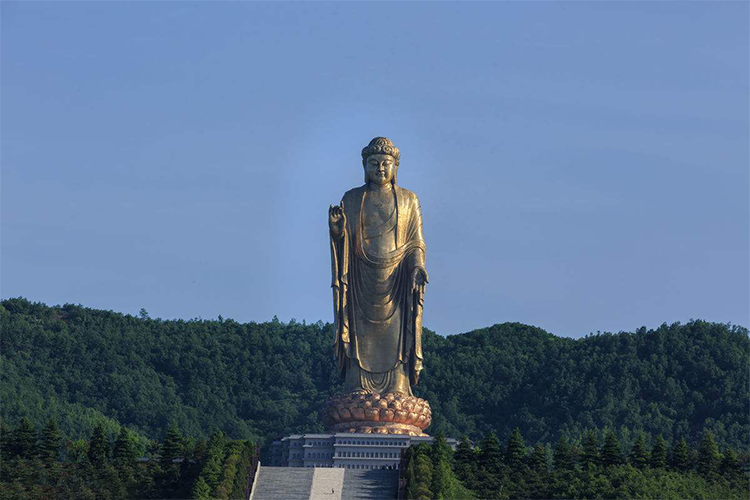Visiting the 208m Central Plains Giant Buddha: A Pilgrim’s Guide
Introduction:
When the first morning light slips through Yao Mountain’s mist and touches the gilded surface of the colossal Buddha, the whole valley seems to become sacred. The Central Plains Giant Buddha rises 208 meters between the peaks, its left hand in the fearlessness mudrā and its right hand lowered to welcome beings. The bronze-gold figure, sometimes veiled by clouds, is not only Guinness-certified as the world’s tallest Buddhist statue but also part of a spiritual complex that blends a Tang-dynasty temple, mountain forests that act as a natural oxygen bar, and restorative hot springs. Follow this guide to uncover the thousand-year stories of this Central Plains Buddhist sanctuary.
1. World-class Buddhist Wonder
The park is structured around the principle of “one Buddha, one temple, one mountain.” Its centerpiece is the 208-meter Lushena (Vairocana) Great Buddha — the height of about a 70-story building. Even the Buddha’s hands measure about 19 meters long, and its lotus pedestal features 108 gilded petals symbolizing the 108 defilements transcended in Buddhism. From the Wish Terrace at the mountain base, the compassionate, downward-gazing face is clearly perceptible even from far away — an awe that must be experienced in person.
The statue’s construction is a modern religious engineering feat: 3,300 tons of bronze were used and more than 6,000 gold sheets cover the exterior; the project took 12 years to complete. Its design follows the canonical proportions found in Buddhist texts, with symbolic details at every turn. For example, the 365-meter Fortune-Wisdom Avenue beneath the Buddha is flanked by 12 pairs of stone guardian deities, representing diligent practice through the four seasons.
2. Foquan Temple: Tang Dynasty Zen Across a Millennium
Behind the Giant Buddha sits Foquan Temple (Buddha Spring Temple), the spiritual heart of the site. Founded during the Zhenguan years of the Tang dynasty, the temple is famous for its mysterious “Eight Merits Spring.” Devotees say this spring water possesses eight virtues — purity, coolness, sweetness, lightness, moistening, peace, relief from hunger and thirst, and nourishment of wholesome roots. Pilgrims still come to scoop a sip with bamboo ladles; you might try a small taste and feel a living thread of faith that stretches back a thousand years.
The temple buildings rise up the mountainside along a central axis, passing the Hall of Heavenly Kings, the Mahavira Hall, and the Sutra Repository. The Mahavira Hall is a highlight: inside are finely gilded Ming-dynasty statues of the Three Buddhas, and the coffered ceiling retains Tang-style painted motifs. If you time your visit to coincide with the monks’ morning liturgy (summer 05:30–06:30), you will hear chanting and bell-and-drum resonance washing over the valley at dawn.
3. Yao Mountain: Natural and Cultural Gifts
Yao Mountain, part of the Funiu range, has a main peak of 2,153 meters that forms a dramatic backdrop for the site. With 97% forest cover it truly functions as a “natural oxygen bar.” There are three main hiking options of varying difficulty:
– Light route: Take the cable car to mid-mountain and stroll among ancient ginkgo groves.
– Cultural route: Explore cliff inscriptions and remnants of Song-era tea-horse roads.
– Challenge route: Hike to the Jade Emperor Summit for sunrise above the sea of clouds.
Seasons transform the landscape: peach blossoms and temple flowers in spring, cool waterfalls in summer, vivid autumn foliage described as a “glazed world” in sutras, and rime and ice in winter that heighten the meditation-like atmosphere. After descending, consider the nearby Lushan hot springs: mineral-rich waters that pair naturally with the Buddhist idea of compassionate healing.

4. Deep Experiences and Practical Tips
Pilgrimage rituals:
– Offer a lamp at the Buddha (CNY 30 per lamp) and hang a wish card along the Bodhi Corridor.
– Follow devotees and circumambulate the Buddha clockwise three times; touch the prayer beads for blessings.
– Large offering ceremonies are held on the 1st and 15th days of the lunar month.
Best visiting strategies:
– Quiet hours: Weekdays 07:00–09:00 to avoid weekend crowds.
– Photo spots: Wish Terrace for a full-Buddha panorama; the rear slopes of Foquan Temple for dramatic “Buddha light through clouds” shots.
– Hidden gem: Stone-carved Song-dynasty Diamond Sutra stelae in the temple grove are often overlooked.
Practical information:
– Opening hours: 08:00–17:30 (extended to 18:30 in peak season).
– Tickets: CNY 120 (includes access to the Giant Buddha and Foquan Temple); sightseeing shuttle CNY 30 extra.
– Transport: Direct “Zhengzhou–Yao Mountain” buses from Zhengzhou coach station (approx. 2.5 hours).
– Clothing: Avoid short skirts and sleeveless tops in temple areas; wear slip-resistant hiking shoes for mountain trails.
– Restrictions: The interior of the Buddha statue is closed to visitors; drone flights require advance approval.
5. Modern Meaning of a Cultural Pilgrimage
At the intersection of technology and faith, the Central Plains Giant Buddha complex shows how Buddhism has adapted to the modern era in China. It offers both a breathtaking material achievement and a deep spiritual experience. Touch the weathered Tang brick at Foquan Temple or gaze up at the Buddha framed against the night sky, and you may realize that a “sacred place” is simply somewhere modern life pauses — where landscape and belief restore inner calm.

Suggested itinerary:
Combine this site with Longmen Grottoes in Luoyang (2-hour drive) and Shaolin Temple on Mount Song (3-hour drive) to form a Central Plains Buddhist triangle. Allow at least four hours on-site; plan a full day if you want to sample vegetarian temple meals and the hot springs.


